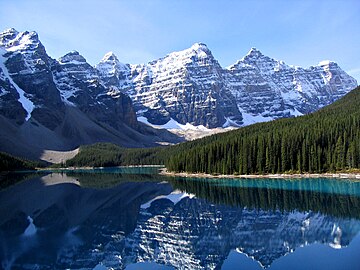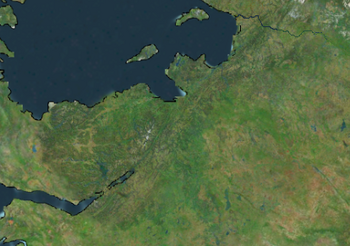Zian Mountains
This article is incomplete because it is pending further input from participants, or it is a work-in-progress by one author. Please comment on this article's talk page to share your input, comments and questions. Note: To contribute to this article, you may need to seek help from the author(s) of this page. |
| Zian Mountains | |
|---|---|
 Lake Themba in Zian Mountain National Park | |
| Highest point | |
| Peak | Grouse Mountain |
| Elevation | 4,970 m (16,310 ft) |
| Dimensions | |
| Length | 2,100 km (1,300 mi) |
| Width | 212 km (132 mi) |
| Geography | |
| Countries | Zamastan |
| Geology | |
| Age of rock | Carboniferous |
| Type of rock | Metamorphic, igneous, sedimentary |
The Zian Mountains, sometimes referred to as the Zians or the Coastal Range, are a major mountain range in western Euronia that extends through northwestern Zamastan along the Horseshoe Bay Valley. They are the second-longest mountain range in the country after the Louise Mountains, and contain the highest peaks in Zamastan including Grouse Mountain at 4,970 m (16,310 ft). The mountains lie within the provinces of Zian, Northern Isle, Pahl, and Jade, and they hold a significant contribution to the mining sectors of the Economy of Zamastan being rich in ores and rare-earth minerals. Several of the peaks in the range are volcanoes, and of the eruptions in continental Zamastan over the last 200 years have been from Zian volcanoes. The two most recent were Koolen Peak from 1914 to 1921 and a major eruption of Mount Amily in 1989. Minor eruptions of Mount Amily have also occurred since, most recently from 2004 to 2018.
Formed by the subduction of the Zian and Caspiaa plates, the Zian Mountains are seperated from the Saladona Range in Gladysynthia by the Danaska River. Overall, the mountains are extremely rugged; even the lesser peaks are steep and glaciated, and valleys are quite low relative to peaks and ridges, so there is great local relief. Because the range is near the Olympic Ocean and in the region's prevailing westerly winds, there is much rain and snow there, especially on the western slopes due to orographic lift, with annual snow accumulations of up to 1,000 inches (2,500 cm) (= 83 feet (25 m)) in some areas. Forests of large, coniferous trees (western red cedars, firs, hemlocks, firs, pines, spruces, and others) dominate most of the Range. Cool, wet winters and warm, dry summers (largely a result of oceanic influence) favor evergreen species, whereas mild temperatures and rich soils promote fast and prolonged growth.
